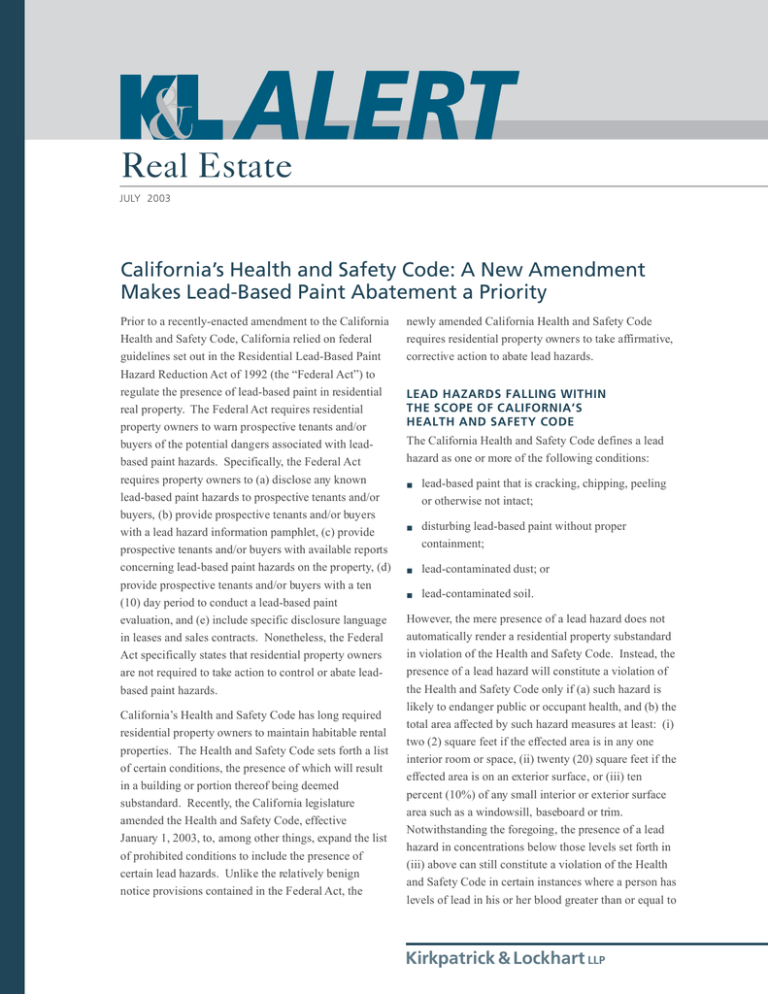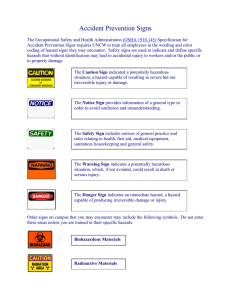
Real Estate
JULY 2003
California’s Health and Safety Code: A New Amendment
Makes Lead-Based Paint Abatement a Priority
Prior to a recently-enacted amendment to the California
Health and Safety Code, California relied on federal
guidelines set out in the Residential Lead-Based Paint
Hazard Reduction Act of 1992 (the “Federal Act”) to
regulate the presence of lead-based paint in residential
real property. The Federal Act requires residential
property owners to warn prospective tenants and/or
buyers of the potential dangers associated with leadbased paint hazards. Specifically, the Federal Act
requires property owners to (a) disclose any known
lead-based paint hazards to prospective tenants and/or
buyers, (b) provide prospective tenants and/or buyers
with a lead hazard information pamphlet, (c) provide
prospective tenants and/or buyers with available reports
concerning lead-based paint hazards on the property, (d)
provide prospective tenants and/or buyers with a ten
(10) day period to conduct a lead-based paint
evaluation, and (e) include specific disclosure language
in leases and sales contracts. Nonetheless, the Federal
Act specifically states that residential property owners
are not required to take action to control or abate leadbased paint hazards.
California’s Health and Safety Code has long required
residential property owners to maintain habitable rental
properties. The Health and Safety Code sets forth a list
of certain conditions, the presence of which will result
in a building or portion thereof being deemed
substandard. Recently, the California legislature
amended the Health and Safety Code, effective
January 1, 2003, to, among other things, expand the list
of prohibited conditions to include the presence of
certain lead hazards. Unlike the relatively benign
notice provisions contained in the Federal Act, the
newly amended California Health and Safety Code
requires residential property owners to take affirmative,
corrective action to abate lead hazards.
LEAD HAZARDS FALLING WITHIN
THE SCOPE OF CALIFORNIA’S
HEALTH AND SAFETY CODE
The California Health and Safety Code defines a lead
hazard as one or more of the following conditions:
■
lead-based paint that is cracking, chipping, peeling
or otherwise not intact;
■
disturbing lead-based paint without proper
containment;
■
lead-contaminated dust; or
■
lead-contaminated soil.
However, the mere presence of a lead hazard does not
automatically render a residential property substandard
in violation of the Health and Safety Code. Instead, the
presence of a lead hazard will constitute a violation of
the Health and Safety Code only if (a) such hazard is
likely to endanger public or occupant health, and (b) the
total area affected by such hazard measures at least: (i)
two (2) square feet if the effected area is in any one
interior room or space, (ii) twenty (20) square feet if the
effected area is on an exterior surface, or (iii) ten
percent (10%) of any small interior or exterior surface
area such as a windowsill, baseboard or trim.
Notwithstanding the foregoing, the presence of a lead
hazard in concentrations below those levels set forth in
(iii) above can still constitute a violation of the Health
and Safety Code in certain instances where a person has
levels of lead in his or her blood greater than or equal to
Kirkpatrick & Lockhart LLP
ten (10) micrograms per deciliter. Should a lead hazard
be present in concentrations sufficient to constitute a
violation of the Health and Safety Code, the residential
property owner has an affirmative obligation to abate
such hazard.
ENFORCEMENT OF CALIFORNIA’S
HEALTH AND SAFETY CODE
The Health and Safety Code grants authority to the
local building/housing departments and/or the city,
county or city and county health departments to enforce
the abatement of lead hazards from residential
properties. The statute further requires these local
agencies to coordinate enforcement activities with other
interested agencies in order to avoid unnecessary
duplication, and specifically authorizes any of the local
agencies to enter into an agreement with the State
Department of Health Services regarding enforcement
responsibilities.
CONCLUSION
It is no longer sufficient for the owners of California
residential property to simply warn prospective tenants
and/or buyers of the dangers posed by lead hazards.
The California Health and Safety Code now obligates
the owners of residential property to abate certain lead
hazards. In order to ensure compliance with the lead
hazard provisions of the Health and Safety Code,
various local agencies have been vested with the
enforcement power to order the prompt removal of such
hazards.
Should an appropriate enforcement agency determine
that a particular building or part thereof contains a lead
hazard in violation of the Health and Safety Code, that
agency is now required to serve the property owner with
notice of the violation. Upon the receipt of a notice of a
violation, a residential property owner may choose
whether to repair or demolish the building so long as
such decision is timely and capable of being, and
actually is, accomplished within a reasonable amount of
time. However, if the enforcement agency determines
that the owner failed to comply with any of those
requirements, it may order (or even perform) the
vacation, demolition or repair of the building or take
any other appropriate action.
The Los Angeles City Council recently approved a pilot
program designed to enforce the lead hazard provisions
of the Health and Safety Code. This pilot program is
expected to begin in August 2003 and will target the 1st ,
8th, 9th, 13th and 14th council districts. Under Los
Angeles’ pilot program, city housing inspectors may use
swabs to detect the presence of lead hazards and, in the
event a lead hazard is detected, the property owner will
be ordered to take affirmative, corrective measures to
abate such hazard.
WILLIAM J. BERNFELD
wbernfeld@kl.com
310.552.5014
PIERCE RICHARDSON
prichardson@kl.com
412.355.6786
DA
VID P
DAVID
P.. SCHACK
dschack@kl.com
310.552.5061
SETH WILSON
seth.wilson@kl.com
412.355.8399
FOR MORE INFORMATION on this Alert or other real estate issues,
please feel free to contact one of the Kirkpatrick & Lockhart lawyers
listed below.
Howard A. Levine
Boston
617.951.9290 hlevine@kl.com
Michael J. Butler
Dallas
214.939.4941
mbutler@kl.com
R Timothy Weston
Harrisburg
717.231.4504
tweston@kl.com
William J. Bernfeld
Los Angeles
310.552.5014
wbernfeld@kl.com
Daniel A. Casey
Miami
305.539.3324
dcasey@kl.com
John M. Marmora
Newark
973.848.4016
jmarmora@kl.com
Elwood F. Collins
New York
212.536.4005
ecollins@kl.com
David H. Ehrenwerth
Pittsburgh
412.355.6532
dehrenwerth@kl.com
Peter W. Sheats
San Francisco 415.249.1030
psheats@kl.com
Thomas F. Cooney, III
Washington
tcooney@kl.com
202.778.9076
®
Kirkpatrick & Lockhart LLP
Challenge us. ®
www.kl.com
BOSTON
■
DALLAS
■
HARRISBURG
■
LOS ANGELES
■
MIAMI
■
NEWARK
■
NEW YORK
■
PITTSBURGH
■
SAN FRANCISCO
■
WASHINGTON
.........................................................................................................................................................
2
This publication is for informational purposes and does not contain or convey legal advice. The information herein
should not be used or relied upon in regard to any particular facts or circumstances without first consulting a lawyer.
KIRKPATRICK & LOCKHART LLP REAL ESTATE ALERT
© 2003 KIRKPATRICK & LOCKHART LLP.
ALL RIGHTS RESERVED.





